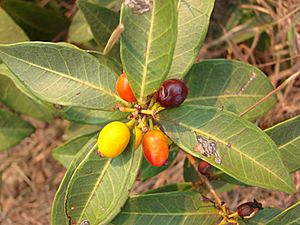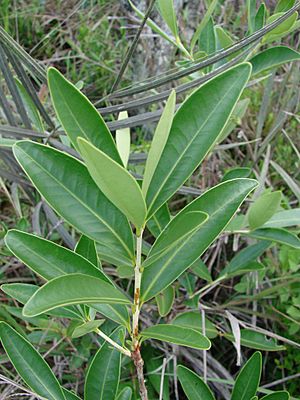Savannah cherry facts for kids
Quick facts for kids Savannah cherry |
|
|---|---|
 |
|
| Fruiting Eugenia calycina plant | |
| Scientific classification | |
| Genus: |
Eugenia
|
| Species: |
calycina
|
| Varieties | |
|
Eugenia calycina var. herbacea (O.Berg) Mattos |
|
| Synonyms | |
|
|
Eugenia calycina, also known as savannah cherry or field cherry, is a flowering shrub. It belongs to the Myrtaceae family, which includes plants like guava and eucalyptus. People also call it Jabuti cherry, Grao de galo, cerejinha, cereja de cerrado, pitanga-vermelha, red pitanga, pitanga cherry of cerrado, and ca-ajaboti.
Contents
Where Does Savannah Cherry Grow?
Eugenia calycina is originally from Brazil. You can find it in states like Goias, Sao Paulo, Minas Gerais, Mato Grosso do Sul, and Parana.
It grows naturally in savannahs and open fields. This plant can be found at high places, up to 1600 meters (5249 feet) above sea level. It especially likes drier areas.
What Does Savannah Cherry Look Like?
Eugenia calycina is a shrub that can grow up to 2 meters (6.5 feet) tall. However, it is usually between 0.7 meters (2 feet) and 1.5 meters (5 feet) in height.
Its leaves are narrow and feel a bit like leather. They are always green and shaped like an oval.
Flowers and Fruit
The flowers of the savannah cherry are pinkish-white. They have four round petals. These flowers grow on the sides of the plant's stems. They can be from 1.5 to 5.8 centimeters (0.5 to 2 inches) long.
The fruit is shaped like an oval and turns dark red to purple when it is ready to eat. Each fruit is about 2.5 centimeters (1 inch) long and 1.5 centimeters (0.5 inches) wide. At the bottom of each fruit, there are at least two pointed, heart-shaped bracts. These are small leaf-like parts that measure 0.9 to 2.2 centimeters (0.3 to 0.8 inches) long.
The fruit is safe to eat and tastes mildly sweet, like berries. Inside, it has one seed. This seed is called a recalcitrant seed, meaning it cannot dry out without dying.
Growth and Conditions
The seeds usually sprout after 30 to 45 days of being planted. The young plants grow quickly. They can reach about 20 centimeters (8 inches) tall in just 10 months.
Eugenia calycina starts to produce fruit when it is 2 to 3 years old. It flowers in the spring and fruits from November to January.
This plant prefers to grow in full sunlight or partial shade. It can handle different climates, including semi-dry, rainy temperate, and tropical dry or wet areas. It can even survive light frost down to -4 degrees Celsius (25 degrees Fahrenheit). It also tolerates heat up to 42 degrees Celsius (107 degrees Fahrenheit).
The savannah cherry grows well in sandy-loam soils and sandy soils with quartz. It prefers soil with a pH level from 4.5 to 6.7, and it needs some moisture.
How People Use Savannah Cherry
The fruit of Eugenia calycina is often collected from the wild. People eat it fresh or use it to make jellies and sweets.
Native people have also used this fruit to help treat diabetes.
What's Inside the Plant?
The fruit of Eugenia calycina is full of vitamin A, which is good for your eyes and immune system.
Scientists have found special compounds called sesquiterpenes in the leaves. These include bicyclogermacrene, spathulenol, and beta-caryophyllene.
The essential oil from the leaves has been studied for its ability to fight mosquito larvae. It works well against the larvae of Aedes aegypti, which is the mosquito that spreads diseases like dengue. The oil shows low harm to human cells, making it a promising natural way to control mosquitoes.
The leaves, fruit pulp, and seeds of Eugenia calycina have a lot of phenolic compounds. Ellagic acid is a main compound found in these parts. These compounds are known for being good for health.
The plant contains many different phytochemicals, which are natural chemicals found in plants. These include organic acids, phenolic acids, and flavonoids. Because of these healthy compounds, Eugenia calycina has great potential as a healthy food.
Some compounds in the plant, especially those with a lot of oxygen, have shown activity against certain types of fungi, like Cryptococcus species. This means Eugenia calycina could be useful in finding new ways to treat fungal infections like cryptococcosis.
See also
 In Spanish: Jabuti para niños
In Spanish: Jabuti para niños


